the 2007 Abstract Presentations - Wound Healing Society
the 2007 Abstract Presentations - Wound Healing Society
the 2007 Abstract Presentations - Wound Healing Society
You also want an ePaper? Increase the reach of your titles
YUMPU automatically turns print PDFs into web optimized ePapers that Google loves.
<strong>Abstract</strong>s<br />
78<br />
INCREASED SUSCEPTIBILITY TO WOUND INFECTION IN<br />
DIABETIC PIGS<br />
Spielmann M. 1,3 , Hirsch T. 1,3 , Zuhaili B. 1 , Fossum M. 1 , Steinau H.U. 3 ,Yao<br />
F. 1 , Onderdonk, A.B. 2 , Steinstraesser L. 3 , Eriksson E. 1<br />
1 Div of Plastic Surgery and,<br />
2 Channing Laboratory, Department of Pathology and Medicine, Brigham &<br />
Women’s Hospital of Harvard Medical School, Boston, MA,<br />
3 Dept. for Plastic Surgery, Burn Center, BG University Hospital<br />
Bergmannsheil, Ruhr University Bochum, Germany<br />
Introduction: <strong>Wound</strong> infection is a common complication in diabetic patients<br />
and <strong>the</strong> progressive increase of multi-drug resistant bacterial strains has<br />
amplified this problem. In diabetic pigs a study was designed in order to 1.<br />
Monitor endogenous bacterial flora in surgical full-thickness skin wounds. 2.<br />
Attempt to create a stably infected surgical wound with <strong>the</strong> inoculation of<br />
virulent strains of Staphylococcus aureus.<br />
Methods: Full-thickness wounds were created in paraspinal dorsal rows in<br />
diabetic and non-diabetic Yorkshire pigs. The wounds were enclosed in flexible<br />
transparent polyurethane chambers. <strong>Wound</strong>s were inoculated with [2 10 8 ]<br />
colony-forming units of S. aureus. <strong>Wound</strong> fluid was collected daily and tissue<br />
biopsies were taken for bacteriological and histological evaluation at regular<br />
intervals. Reepi<strong>the</strong>lialization was measured on <strong>the</strong> final day of <strong>the</strong> experiment.<br />
Results: S. aureus inoculated diabetic wounds showed a significant invasive<br />
infection with up to 8 10 7 cfu/g per gram of tissue over <strong>the</strong> whole course of <strong>the</strong><br />
experiment. No cross contamination between study wounds and controlled<br />
wounds could be detected. Epi<strong>the</strong>lial healing was significantly delayed compared<br />
to controlled wounds (59% versus 84%; p o 0.05). Diabetic wounds also<br />
contained significantly higher numbers of skin bacteria such as E. Coli,<br />
Steptococcus dysgalactiae and Enterococcus Faecium ( 4 10 5 cfu/g tissue),<br />
compared with non-diabetic wounds, which had (3.2 10 3 cfu/g tissue;<br />
p = 0.042). No S.aureus or was detected in <strong>the</strong> non-inoculated wounds.<br />
Conclusion: In this pig model diabetic wounds are more prone to infection than<br />
non-diabetic wounds. Inoculation with S. aureus creates a sustained infection in<br />
diabetic wounds.<br />
79<br />
THE POTENTIAL ROLE OF<br />
DI-CHLORODIMETHYLTAURINE AS A WOUND TOPICAL<br />
ANTIMICROBIAL THAT DOES NOT INHIBIT HEALING<br />
M.C. Robson 1 , MD, W.G. Payne 1 , MD, F. Ko 1 , BS, G. Donate 1 , DPM, M.<br />
Mentis 1 , DO, S. Shafii 1 , MD, M. Bassiri 2 , PhD, D.M. Cooper 2 , PhD, L.<br />
Wang 2 , PhD, B. Khosrovi 2 , R. Najafi 2 , PhD<br />
1 Institute for Tissue Regeneration, Repair, and Rehabilitation, Bay Pines<br />
VAMC, Bay Pines, Florida University of South Florida, Division of Plastic<br />
Surgery and,<br />
2 NovaCal Pharmaceuticals, Inc<br />
Di-chlorodimethyltaurine is a stable derivative of <strong>the</strong> naturally produced<br />
molecule, chlorotaurine, which is released during <strong>the</strong> oxidative burst within<br />
innate immune cells when <strong>the</strong> host responds to invading bacteria. Because of<br />
greater stability and lesser toxicity than hypochlorous acid, it is thought to have<br />
potential as a safe, topical, non- antibiotic antimicrobial for decreasing <strong>the</strong><br />
bacterial bioburden in wounds. To test this hypo<strong>the</strong>sis, an established rodent<br />
model of a chronically infected granulating wound was used. Twenty-five<br />
Sprague-Dawley rats underwent 30% TBSA dorsal scald burns and were<br />
inoculated with 5 10 9 E.coli. On <strong>the</strong> 5 th post-burn day, escharectomies were<br />
performed leaving a granulating wound with 4 10 8 bacteria/gm. of tissue.<br />
Four regimens of topical di-chlorodimethyltaurine were tested versus 0.9%<br />
NaCl as a control. Every 72 hours, wounds were traced for planimetry and<br />
biopsied for quantitative bacteriology. <strong>Wound</strong> areas were plotted against time<br />
for each group. By day 7 three of <strong>the</strong> four drug treatment regimens statistically<br />
decreased <strong>the</strong> bacterial bioburden compared with <strong>the</strong> control (P o 0.05). The<br />
regimen of pH 4.0, 12 mM dichlorodimethyltaurine applied for 30 minutes,<br />
gently removed, and reapplied for 23 1/2 hrs. was most effective, totally<br />
eradicating <strong>the</strong> tissue bacterial load by 10 days (P o 0.001). Three of <strong>the</strong> four<br />
regimens accelerated wound closure compared with <strong>the</strong> control. Only <strong>the</strong><br />
40 mM solution caused <strong>the</strong> wounds to heal worse than <strong>the</strong> control due to local<br />
wound toxicity at <strong>the</strong> increased concentration. In conclusion, dichlorodimethyltaurine<br />
appeared to be an effective antimicrobial which did not damage<br />
cells, and allowed <strong>the</strong> wound to progress to healing. Research sponsored by a<br />
grant from NovaCal Pharmaceuticals, Inc.<br />
80<br />
DETECTION OF PSEUDOMONAS AERUGINOSA QUORUM<br />
SENSING SIGNALS IN AN INFECTED ISCHEMIC WOUND:<br />
AN EXPERIMENTAL STUDY IN RATS<br />
G. Nakagami 1 , H. Sanada 1 , J. Sugama 2 , T. Morohoshi 3 , T. Ikeda 3 , Y. Ohta 4<br />
1 The University of Tokyo,<br />
2 Kanazawa University,<br />
3 Utsunomiya University,<br />
4 Toranomon Hospital<br />
Diagnosis of critical colonization or local infection of chronic wounds provides<br />
several difficulties because of lack of typical clinical symptoms and inaccuracy of<br />
bacteriological culture. Quorumsensing, a cell-to-cell communication that occurs<br />
via autoinducers, regulating a number of virulent factors of bacteria would<br />
play a key role in establishment of <strong>the</strong> critical colonization or local infection;<br />
however, little is known about its role in chronic wound infection in vivo.<br />
Signaling molecules mediate <strong>the</strong> communication, and when its concentration<br />
reaches a specific level, bacteria alter <strong>the</strong>ir behavior. Pseudomonas aeruginosa, a<br />
common causative pathogen for wound infection, uses N-(3-oxododecanoyl)-<br />
homoserine lactone (3OC12-HSL) as an autoinducer for lasR-lasI quorum<br />
sensing system, a major quorumsensing system of P. aeruginosa. This study<br />
was designed to quantify an autoinducer from P. aeruginosa-infected wounds<br />
with <strong>the</strong> aim of examining <strong>the</strong> possible use of autoinducers as an indicator of<br />
chronic wound infection. Pressure-induced ischemic wounds were infected with<br />
P. aeruginosa PAO1, which has a complete quorum sensing mechanism (N = 6)<br />
or uninfected as a control (N = 6). 3OC12-HSL was quantified by bioassay<br />
method employing Escherichia coli DH5a (pJN105L, pSC11), which expresses<br />
b-galactosidase when exposed to P. aeruginosa quorum sensing signals. We<br />
confirmed successful infection by bacteriological counts (over 10 5 colony<br />
forming units per gram of tissue) and histopathological changes. The concentration<br />
of autoinducer was 0.89 pmol/g at day three and 0.19 pmol/g at day seven in<br />
<strong>the</strong> infected wounds, as detected from tissue samples. We also detected <strong>the</strong><br />
autoinducer in exudate samples of <strong>the</strong> infected wounds. No autoinducer was<br />
detected in <strong>the</strong> control group from tissue or exudate samples. Our findings<br />
indicate that autoinducers could play a role in in vivo wound infection models,<br />
and also suggest possible clinical implications of autoinducer signal quantification<br />
in diagnosis of critical colonization or chronic wound infection.<br />
Acknowledgments: This study was supported by grant-in-aid for scientific<br />
research from <strong>the</strong> Japanese <strong>Society</strong> of Pressure Ulcers.<br />
81<br />
THE EFFECT OF DAKIN’S SOLUTION ON COLLAGEN AND<br />
CELL MIGRATION<br />
Roshada Bozeman 1 , Ryan Claire Propst 2 ,andAnnette B. Wysocki 2<br />
Tougaloo College, Tougaloo, MS 39174 and University of Mississippi Medical<br />
Center, Jackson, MS 39216<br />
Open chronic skin wounds are colonized with bacteria that can lead to<br />
subsequent infection. Topical antiseptics are commonly used to control this<br />
bacterial colonization. The use of Dakin’s solution, a topical antiseptic, on<br />
chronic open skin wounds remains controversial in clinical care because of its<br />
reported damaging effects. Here we tested four different formulations of<br />
Dakin’s solution, 0.5% (full strength), 0.25% (half-strength), 0.125% (quarter<br />
strength) and 0.0125% (diluted strength), to determine if it degrades collagen or<br />
impairs cell migration that may lead to delayed wound healing. To do this we<br />
added varying amounts of Dakin’s solution to acid solubilized type I collagen,<br />
with and without serum, at two different time points that were <strong>the</strong>n mixed.<br />
Subsequently we used 8% SDS PAGE to determine <strong>the</strong> extent of degradation<br />
using colorimetric detection with Coomassie stain to visualize <strong>the</strong> collagen. To<br />
determine <strong>the</strong> effect on cell migration we used a dermal equivalent model where<br />
fibroblasts are incorporated into a three dimensional collagen gel (3D gel) and<br />
<strong>the</strong>n substituted varying amounts of each of <strong>the</strong> Dakin’s solutions into <strong>the</strong><br />
media, with and without serum, and <strong>the</strong>n counted <strong>the</strong> number of cells that<br />
migrated at two different time points. Our results indicate that <strong>the</strong> 0.0125%<br />
Dakin’s solution resulted in little or no collagen degradation compared to<br />
higher concentrations, where collagen was ei<strong>the</strong>r completely or partially<br />
degraded. Likewise, cell migration was completely inhibited using <strong>the</strong> 0.5%<br />
Dakin’s solution compared to <strong>the</strong> 0.0125% solution where cells were still able<br />
to migrate. Fur<strong>the</strong>rmore, we noted that serum had a protective effect for both<br />
collagen degradation and cell migration and that time exposure was a factor in<br />
our collagen degradation experiments. Thus, we conclude that <strong>the</strong>re is a<br />
dilution, serum, and time effect that can be used to attenuate <strong>the</strong> effect of<br />
Dakin’s solution on collagen degradation and cell migration. Supported by a<br />
fellowship from <strong>the</strong> Mississippi Functional Genomics Network to Ms. Roshada<br />
Bozeman. Century Pharmaceuticals donated <strong>the</strong> Dakin’s solution.<br />
<strong>Wound</strong> Rep Reg (<strong>2007</strong>) 15 A14–A54 c <strong>2007</strong> by <strong>the</strong> <strong>Wound</strong> <strong>Healing</strong> <strong>Society</strong><br />
A35




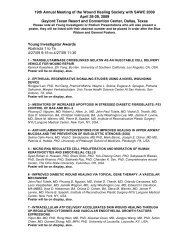

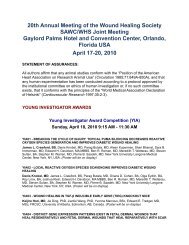
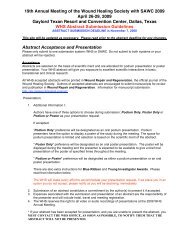
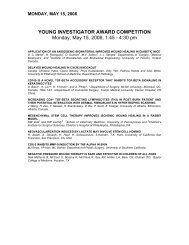



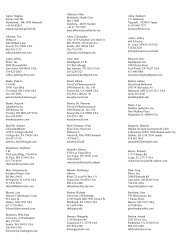
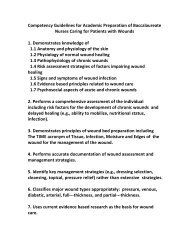
![2010 Abstracts-pah[2] - Wound Healing Society](https://img.yumpu.com/3748463/1/190x245/2010-abstracts-pah2-wound-healing-society.jpg?quality=85)